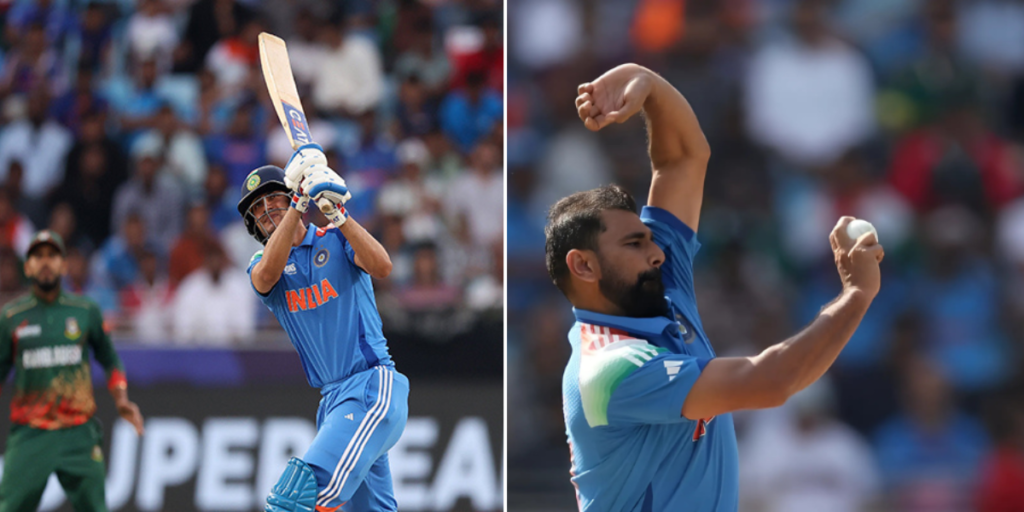The ICC Champions Trophy 2025 began for Team India with tremendous power when they defeated Bangladesh by six wickets at the Dubai International Stadium on February 20, 2025. India’s complete victory had a foundation of Shubman Gill’s steady 100-run century and Mohammed Shami’s outstanding five-wicket performance. Using these victories India began their tournament establish their place in the competition while simultaneously showcasing the new talents who would lead them during crucial moments.
Shami’s Masterclass: A Bowling Spectacle
The 5 wickets Shami claimed during his 10 overs marked his place as the 12th player and the first Indian pacer to achieve a five-wicket haul in Champions Trophy history. In this Champions Trophy he became the first Indian bowler to accomplish this milestone. Shami used the conditions and important opportunities to limit Bangladesh to a total of 228 runs.
From the opening over Shami demonstrated his authority by dismissing Soumya Sarkar as the Bangladesh opener without any runs. Shami complicated Bangladesh’s efforts further in the fourth over by dismissing Miraz and then separated Hridoy and Jaker Ali during their extensive 154-run relationship by removing Ali for 68. During the final few overs Shami completed a strategic effort by eliminating the tail batsmen with Hridoy being the important catch before he could reach a century.
Gill’s Century: A Masterclass in Anchoring the Chase
Through his outstanding bowling performances Shami established favorable conditions for Shubman Gill who smacked an undefeated century to let India complete the chase without difficulty. Gill showcased his unparalleled batting skills by reaching 101 runs after facing 129 balls while playing against
Dubai pitch conditions. Gill regained his status as one of the reliable middle-order batsmen in ODI cricket by hitting consecutive hundreds.
Gill displayed dominant leadership by playing delicate shots both toward square and down the ground during the first over of play. The batsman made precise batting decisions while respecting strong pitches yet destroyed anything that differed from that style. Gill’s tactical batting advancement as middle order batsman during the match allowed the team to both overwhelm the opponents with fatigue and maintain a constant flow of runs. The hundred runs scored by Gill displayed both his own exceptional performance while providing the foundation for India’s victorious approach. Gill proved his elite batting skills while forming key team synergies as part of his run chase before finishing the innings in masterful style with fast and spin bowling.
Bangladesh’s Fightback: Hridoy and Ali’s Resilience
Two exceptional players named Towhid Hridoy and Jaker Ali brought outstanding performance during Bangladesh’s loss. The sixth-wicket pair notched down 154 runs together after Bangladesh lost five wickets inside nine overs which became the highest sixth-wheel total ever recorded in Champions Trophy history.
Hridoy proved his determination by scoring his first ODI century during the match. The batter overcame his cramp condition by hitting six boundaries and two sixes during his 100-run achievement from 118 balls. The courageous contribution by Jaker Ali combined with his 68 runs created a competitive fighting opportunity for Bangladesh. Bangladesh’s batting efforts did not manage to match up with India’s player depth and quality during the match.
Team Effort That Led to a Comprehensive Win
While Shami and Gill were notable performers, India’s success was based on a collective effort. The bowlers worked wonderfully together, with the spinners also playing an essential role in tightening the noose around the opposition’s batting lineup. The fielding was crisp, with critical catches made at the proper time, preventing any partnerships from flourishing. The middle order contributed to Gill’s success by ensuring that the team did not take unnecessary risks. Experienced players contributed to the team’s stability, demonstrating its depth and ability to produce under duress.
Captain’s Strategic Brilliance
While Shami and Gill were notable performers, India’s success was based on a collective effort. The bowlers worked brilliantly together, with the spinners also playing a key role in tightening the opposition batting line-up. The fielding was superb, with key catches taken at the right time, preventing any partnership from flourishing. The middle order played a key role in Gill’s success by ensuring that the team did not take unnecessary risks. The experienced players contributed to the stability of the team, demonstrating its depth and ability to produce under pressure.







